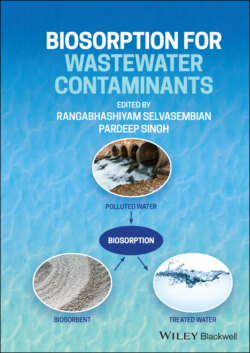Читать книгу Biosorption for Wastewater Contaminants - Группа авторов - Страница 35
Alteration of Biosorbents
ОглавлениеThe amount and accessibility of binding sites on the surface of an adsorbent determine the biosorption technique. Usage of biosorbents in their natural state has shown a number of drawbacks due to their poor biosorption potential and unpredictable physical stability. Modifying the surface features of biosorbents can have a huge impact on the biosorbents’ ability to remove metal particles (Gupta et al., 2002). Several researchers concentrated on altering the biomass chemically such that structural stability and effective heavy metal ion biosorption capability can be achieved.
Hydrophobicity, water absorbency, thermal resistance, cation/anion exchange capacity, and ability to resist microbial attack have been improved significantly by modifying the surface of biomass. Physical pretreatment methods such as heating, chilling, drying, lyophilization, and autoclaving are used to alter the cell surface. Several researchers have reported using chemical pretreatments for surface alteration, including washing with mineral and organic acid solutions, detergents, alkaline solutions, and organic compounds (Vieira and Volesky, 2000). These pretreatments assisted in modifying surface binding sites by eliminating or hiding the groups or exposing further sites to bind metals. Biosorptive performance has been boosted by carboxylation, phosphorylation, and amination of amine, carboxyl, and hydroxyl groups, saponification of ester groups, sulfonation, halogenation, oxidation, and so on (Wan Ngah and Hanafiah, 2008). Various biomasses, irrespective of their source, including pine bark, rose petals, spirogyra, walnut shell, rubber leaves, and sawdust, showed promising biosorption capabilities after alkaline pretreatment (Argun et al., 2009).
